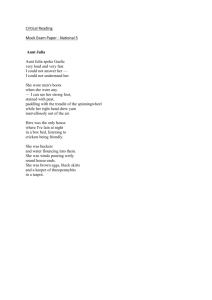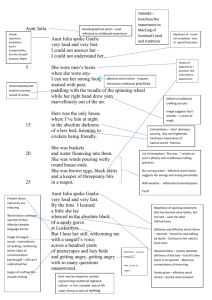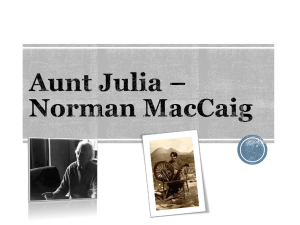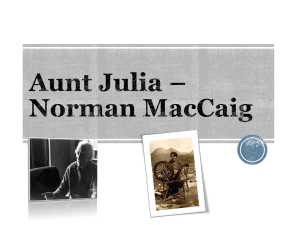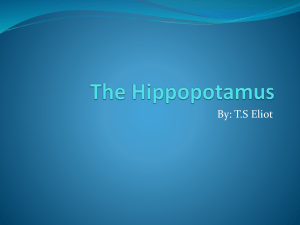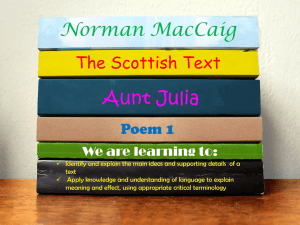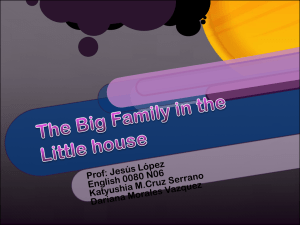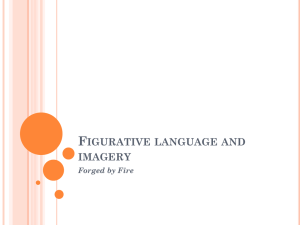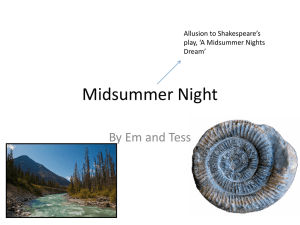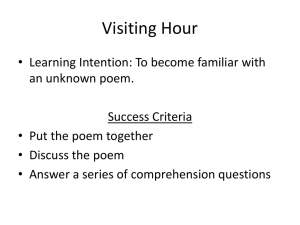Aunt Julia - Scottish Set Texts National 5
advertisement
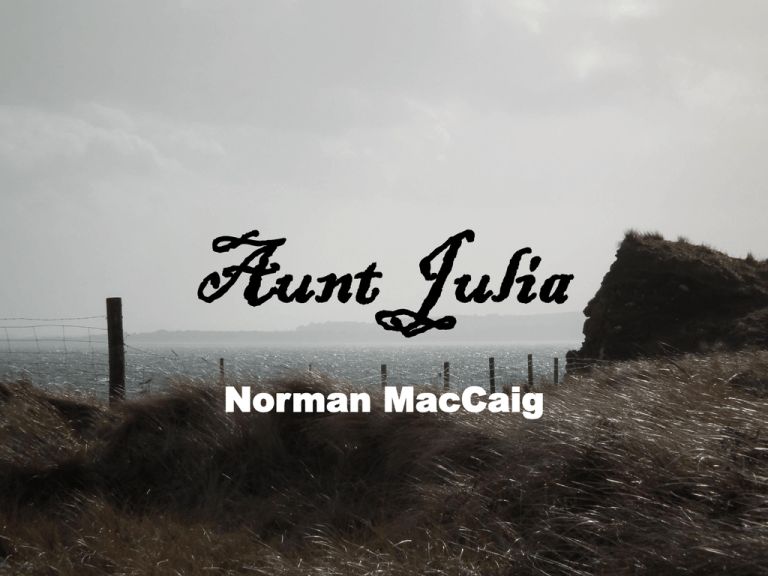
Aunt Julia Norman MacCaig Isle of Harris – Famous for its Harris Tweed! Norman MacCaig was influenced by visits to his mother’s family in the Highlands of Scotland, even though he was brought up in Edinburgh. Aunt Julia Stanza 1 Aunt Julia spoke Gaelic very loud and very fast. I could not answer her — I could not understand her. Stanza 2 She wore men's boots when she wore any. — I can see her strong foot, stained with peat, paddling with the treadle of the spinning wheel while her right hand drew yarn marvellously out of the air. adverb Stanza 3 Hers was the only house where I've lain at night in absolute darkness in a box bed, listening to crickets being friendly. Stanza 4 Personification to suggest something about her character She was buckets and water flouncing into them. She was winds pouring wetly round house-ends. She was brown eggs, Metaphors to black skirts define her hard life and a keeper of threepennybits in a teapot. Stanza 5 Aunt Julia spoke Gaelic very loud and very fast. By the time I had learned a little, she lay silenced in the absolute black of a sandy grave at Luskentyre. Alliteration Stanza 5 continued But I hear her still, welcoming me with a seagull's voice across a hundred yards of peatscrapes and lazybeds and getting angry, getting angry with so many questions unanswered. Key points • The poet pays tribute to his aunt who lived a hard life on the island of Harris in the Western Isles of Scotland • She had a spinning wheel for producing the famous Harris Tweed • The poet uses power of observation to describe her and the settings • She spoke Gaelic which he could not understand Content – 1st stanza • A child’s memory of his aunt– Aunt Julia • Main recollection is her language – Gaelic – which he could not understand Content – 2nd stanza • Describes his aunt and how she seemed strange to him – barefoot, or wearing ‘men’s boots • His description gives an insight into her way of life Content 3rd stanza • He recalls the strange experience of sleeping in a box bed but he feels safe there Content 4th stanza • Vivid images and metaphor capture aspects of her life: carrying buckets of water as there is no running water Content 5th stanza • By the time he learned some Gaelic, it was too late to communicate with his Aunt: she had died • He feels frustrated and ‘angry’ that he was too late to get the chance to chat with her and really get to know her • She could be angry because she didn’t ever experience a life other than her own and didn’t get to know him either. Tone and language • Some language is plain and factual – The two opening lines – Metaphors define her hard life – ‘She was buckets’ • Personification is used to suggest something about Aunt Julia’s character – ‘flouncing’ Tone and language • Her ‘seagull’s voice’ is a metaphor to describe her loud, incomprehensible voice! • Scottish dialect is used in the poem – ‘lazybeds’ Tone and language • The repetition of ‘getting angry’ emphasises his frustration at never having talked to her • Dark images are used throughout the poem to illustrate how basic and bleak things were on the remote island – ‘stained with peat’ ‘absolute darkness’ ‘black skirts’ ‘absolute black • Her loud, fast Gaelic voice is the most memorable thing about her; when she is dead she is ‘silenced’ Other culture • Most obviously the Gaelic language – it seems alien as it could not be understood • Description of features of the landscape • The spinning wheel used for generations to make Harris tweed • The traditional box bed • The use of an actual place name: Luskentyre WRITTEN TASKS • Try your best to work through the eight questions about, ‘Aunt Julia’. Make your answers and detailed and as mature as possible. Use your notes and use the words metaphors and personification! • Imagine that you are the young narrator laying in your box bed listening to the friendly crickets, writing a diary entry about your visit to see Aunt Julia. Extension Task • If you have time, why don’t you try to draw Aunt Julia, and illustrate some of the metaphors around her to show your understanding.
